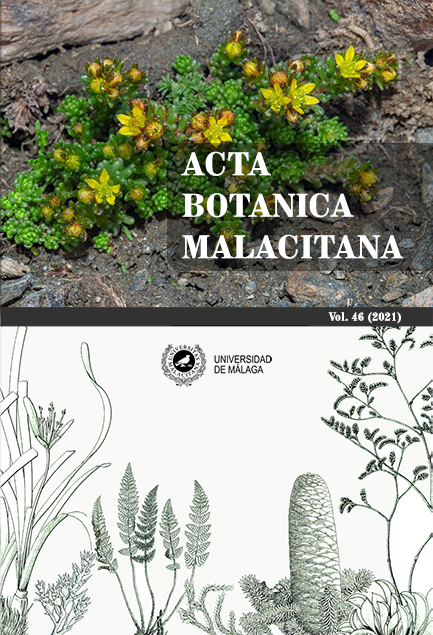Malope trifida Cav. (Malvaceae) in the province of Seville, almost thirty years after its last registration
DOI:
https://doi.org/10.24310/abm.v46i.13155Keywords:
Malope trifida, agricultural land flora, chorology, Western Andalusian, Iberian PeninsulaAbstract
New records of Malope trifida are reported in the province of Seville (southern Spain). His current presence is verified since his last testimony was recorded in 1990, data on its ecology are provided and its regional distribution is expanded.
Downloads
Metrics
References
Barras, F. (1898). Datos para la flórula sevillana. Actas Soc. Esp. Hist., 27, 93-96.
Cavanilles, A.J. (1786). Secundo dissertatione botanica, de Malva, Serra, Malope, Lavatera, Alcea, Althaea et Malachra. París: F. Didot.
Chambouleyron, M. (2012). Contribution a la connaissance de la flore de la peninsula tingitane (Maroc). Lagascalia, 32, 35-227.
Chandler, M., Seeb, L., Copasc, K., Bonded, A.M.Z., Claramunt López, B., Danielsend, F., Legindc, J.K., Masindec, S., Miller-Rushingg, A.J., Newmanh, G., Rosemartini, A. & Turakjk, E. (2017). Contribution of citizen science towards international biodiversity monitoring. Biol. Conserv., 213, 280-294.
DAISIE (2009). Handbook of Alien Species in Europe. Dordrecht: Springer.
Devesa, J. A. (1987). Malvaceae L. En Valdés, B., Talavera, S. & Fernández-Galiano, E. (eds.) Flora vascular de Andalucía occidental vol. 1. Barcelona: Ketres.
Galán de Mera, A. & Vicente Orellana, J. A. (1997). Phytogeographical characterization of SW Cadiz (Spain) and its relationship with the Tingitanean Peninsula (Morocco). Lagascalia, 19, 609-616.
Lázaro Ibiza, B. (1893). Contribuciones a la flora de la Península Ibérica. Notas críticas acerca de la flora española I. Anales Soc. Esp. Hist. Nat., 22, 19-46.
Nogueira, I. & Paiva, J. (1993). Malope L. En S. Castroviejo et al. (eds.) Flora ibérica vol. 3 (pp. 199-201). Madrid: Real Jardín Botánico, CSIC.
Peinado, M., Martínez-Parras, J.M. & Bartolomé, C. (1986) Notas sobre vegetación nitrófila II: algunas novedades fitosociológicas en Andalucía. Studia Botanica, 5, 53-69.
Rivas-Martínez, S. & Izco, J. (1972). Sobre la vegetación terofítica subnitrófila mediterránea (Brometalia rubenti-tectori). Anales Jard. Bot. Madrid, 34, 355-381.
Sánchez de Lorenzo Cáceres, J.M. (ed.). (2002). Flora ornamental española vol. 2. Sevilla: Junta de Andalucía-MundiPrensa-Asociación Española de Parques y Jardines Públicos.
Valdés, B., Talavera, S. & Fernández-Galiano, E. (eds.) Flora vascular de Andalucía occidental, 3 vol. Barcelona: Ketres.
Valladares, F., Tena, D., Matesanz, S., Bochet, E., Balaguer, L., Costa-Tenorio, M., Tormo, I. & García-Fayos, P. (2008). Functional traits and phylogeny: what is the main ecological proccess determining species assemblage in roadside plant communities? J. Veg. Sci., 19, 381-392.
Wróblewska, A. (2006). Pollen efficiency and insect visitation of Malope trifida Cav. flowers. Acta Agrobot., 59, 133-138.
Wróblewska, A. (2009). Study on flowering biology and seed sets of selected ornamental species from the Malvaceae family. J. Apic. Sci., 53, 29-36.
Downloads
Published
How to Cite
Issue
Section
License
All information related to the licensing of published works in Acta Botanica Malacitana and copyright can be found in our Editorial Policy.







1.png)
